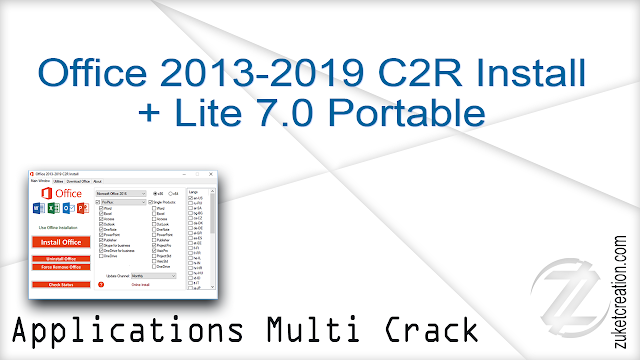
NOTE: This tutorial will work for Office 2013 and later versions such as Office 2016 and Office 2019. Since the release of Office 2010 version, Microsoft has started using a new virtualization technology to distribute Office setup and installation files to users and the technology is called “Click-to-Run” or “C2R Installer“. Sep 13, 2017 As stated in the past, Office C2R and MSI of the same major version cannot be installed side by side. Currently, if you are using Office/Access 2016 C2R, we recommend that you install Access 2013 Runtime MSI if you need a side-by-side setup. The two versions are functionally equivalent, and this installation should work smoothly. Apr 02, 2019 c2r office2016-2019-365toVOL. Contribute to kkkgo/office-C2R-to-VOL development by creating an account on GitHub.
Microsoft Endpoint Configuration Manager has the ability to manage Office updates by using the Software Update management workflow. You can use Configuration Manager to update Microsoft 365 Apps for enterprise or Microsoft 365 Apps for business, as well as the subscription versions of the Project and Visio desktop apps.
When Microsoft publishes a new Office update to the Office Content Delivery Network (CDN), Microsoft simultaneously publishes an update package to Windows Server Update Services (WSUS). Then, Configuration Manager synchronizes the Office update from the WSUS catalog to the site server. Configuration Manager can then download the update and distribute it to distribution points selected by the administrator. The Configuration Manager desktop client then tells Office where to get the update and when to start the update installation process.
Click on the built-in script – Restart stopped Office C2R svc Click on Properties Navigate to the Assignment section and click on Edit to deploy the built-in Proactive Remediation Script Package called Restart stopped Office C2R svc. If this is the first time you're installing Office you may have some setup steps to do first. Expand the learn more section below. However, if you're reinstalling Office, and you've already redeemed a product key and have an account associated with Office, then go to the section sign in and install Office on your PC or Mac.
Here's an overview of the steps to enable Configuration Manager to manage Office updates:
After you perform these steps, you can use the software update management capabilities of Configuration Manager to deploy the updates. For more information, see Manage software updates in Microsoft Endpoint Configuration Manager.
Requirements for using Configuration Manager to manage Office updates
To enable Configuration Manager to manage Office updates, you need the following:

Microsoft Endpoint Configuration Manager (current branch)
Microsoft 365 Apps for enterprise, Microsoft 365 Apps for business, the subscription version of the Project desktop app, or the subscription version of the Visio desktop app.
Supported update channel version for Office. For more details, see Release information for updates to Microsoft 365 Apps
Windows Server Update Services (WSUS) 4.0
You can't use WSUS by itself to deploy these updates. You need to use WSUS in conjunction with Configuration Manager
The hierarchy's top level WSUS server and the top level Configuration Manager site server must have access to the following URLs: *.microsoft.com, *.msocdn.com, *.office.com, *.office.net, *.onmicrosoft.com, officecdn.microsoft.com, officecdn.microsoft.com.edgesuite.net. For more details, see Office 365 URLs and IP address ranges.
On the computers that have the Office installed, the Office COM object is enabled.
Enable Configuration Manager to receive Office 365 client package notifications
To start, you need to configure Configuration Manager to receive notifications when Office update packages are available. To do that, use the following steps:
In the Configuration Manager console, choose Site Configuration > Sites, and then select your site server.
On the Home tab, in the Settings group, choose Configure Site Components, and then choose Software Update Point.
In the Software Update Point Component Properties dialog box, do the following:
On the Products tab, under Office, select Office 365 Client.
On the Classifications tab, select Updates.
You can have other check boxes selected in the Products and Classifications tabs. But, Office 365 Client and Updates need to be selected for Configuration Manager to receive notifications when Office update packages are available.
Next, synchronize software updates. If you don't do that, you won't see the updates in the console and the updates won't be available to deploy. For more information about how to synchronize software updates, see Introduction to software updates in Microsoft Endpoint Configuration Manager.
Enable Office 365 clients to receive updates from Configuration Manager
For Configuration Manager to be able to manage Office updates, an Office COM object needs to be enabled on the computer where Office is installed. The Office COM object takes commands from Configuration Manager to download and install client updates.
You can enable the Office COM object by using client policy in Configuration Manager, Group Policy, or the Office Deployment Tool. If you use more than one method, the Group Policy setting determines the final configuration.
Method 1: Use client policy in Configuration Manager to enable updates from Configuration Manager
To enable Configuration Manager to manage Office updates on specific computers by using client policy, do the following:
- In the Configuration Manager console, click Administration > Overview > Client Settings.
- Open the client settings, click Software Updates and select Yes for the Enable management of the Office 365 Client Agent setting.
For more information, see client policy.
Method 2: Use Group Policy to enable updates from Configuration Manager
You can enable Configuration Manager to manage Office updates on specific computers by using Group Policy. You can apply this setting to multiple computers, an organizational unit (OU), or a domain.

To use Group Policy, do the following:
Office C2r 7.1.6
Download and install the Administrative Template files (ADMX/ADML) for Office from the Microsoft Download Center.
Enable the Management of Microsoft 365 Apps for enterprise policy setting. You can find this policy setting under Computer ConfigurationPoliciesAdministrative TemplatesMicrosoft Office 2016 (Machine)Updates.
Method 3: Use the Office Deployment Tool to enable updates from Configuration Manager
You can use the latest version of the Office Deployment Tool to configure Office to receive updates from Configuration Manager.
To configure this capability, use a text editor, such as Notepad, to modify the configuration file for the Office Deployment Tool. In the Add element, include the OfficeMgmtCOM attribute and set its value to True, as seen in the following example.
We recommend that you also set the value of the Enabled attribute to True in the Updates element (note that this is the default setting). When OfficeMgmtCOM and Updates element are both set to true, updates are still delivered only by Configuration Manager. Note that the scheduled task Office Automatic Updates 2.0, which is registered during Microsoft 365 Apps installation, must remain enabled. That task initiates product configuration tasks such as channel management.
Enable Office 365 clients to receive updates from the Office CDN instead of Configuration Manager
If it meets your business and technical requirements, we recommend updating your client devices automatically from the Office CDN. To enable a device to receive updates from the Office CDN instead of from Configuration Manager, use one of the following methods:

Method 1: Use client policy in Configuration Manager to enable updates from the CDN
Office C2r Client Error
- In the Configuration Manager console, click Administration > Overview > Client Settings.
- Open the appropriate device settings to enable the client agent. For more information about default and custom client settings, see How to configure client settings in Microsoft Endpoint Configuration Manager.
- Click Software Updates and select No for the Enable management of the Office 365 Client Agent setting.
For more information, see client policy.
Method 2: Use Group Policy to enable updates from the CDN
Download and install the Administrative Template files (ADMX/ADML) for Office from the Microsoft Download Center.
Disable the Management of Microsoft 365 Apps for enterprise policy setting. You can find this policy setting under Computer ConfigurationPoliciesAdministrative TemplatesMicrosoft Office 2016 (Machine)Updates.
Important
The Microsoft Office Click-to-Run Service is responsible for registering and unregistering Office COM application during service startup. Change domain policy or Configuration Manager client settings require explicit Disable selection for Office COM to be successfully deregistered and restore default configuration. Toggling Management of Microsoft 365 Apps for enterprise via Group Policy or Client Settings for Configuration Manager from Enabled to Not Configured is not sufficient.

Contents of the Office 365 client update package for WSUS
The update package that Microsoft publishes to WSUS only appears in the WSUS catalog. It doesn't contain a copy of the updated version of Office that's on the Office CDN. Instead, it contains information that Configuration Manager needs to be able to download and distribute the updated version of Office.
The package contains a file named noop.exe. But, that file doesn't contain any code and shouldn't be downloaded or run.
For each update release there are different packages for each architecture and for each update channel. For example, for the May update release, there is a package for the 32-bit edition of Current Channel and a package for the 64-bit edition of Current Channel. In June, there will be two new packages for Current Channel, one for each architecture. The packages contain information so that Configuration Manager knows which packages are more recent than other packages. For example, that the June package supersedes the May package.
There aren't separate packages for the different Office clients. For example, an update package for the 32-bit edition of Current Channel has information about Microsoft 365 Apps for enterprise and Microsoft 365 Apps for business, as well as the subscription versions of the Project and Visio desktop apps.
